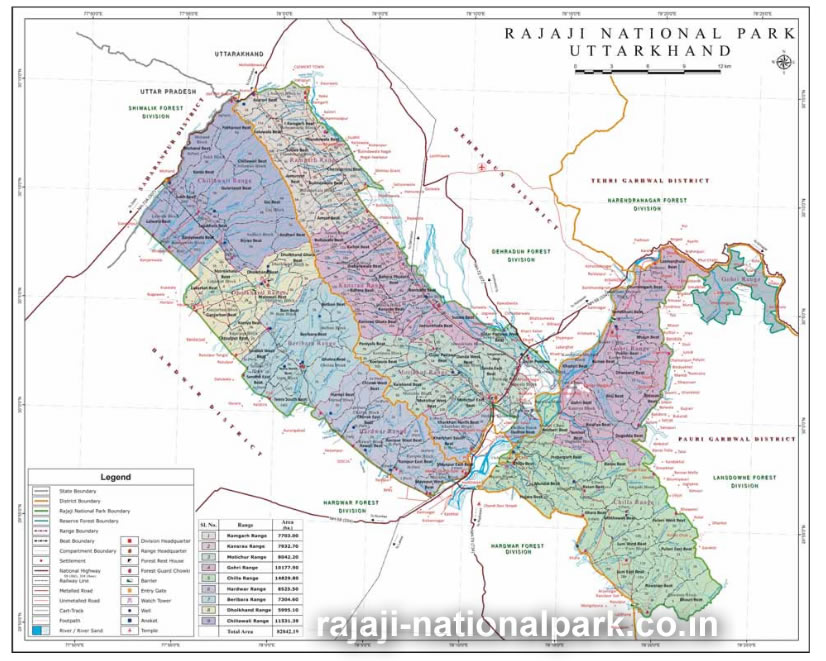Rajaji National Park has inherited its name from the Rajaji Sanctuary, which was one of the constituent units by the amalgamation of which the National Park was created in 1983. The Park was formed by the amalgamation of Rajaji Sanctuary, Motichur Sanctuary, and Chilla Range of Pauri Forest Division.
| S.No. | Name of Sanctuary | Area (Sq.Km.) |
|---|---|---|
| 1 | Motichur | 89.5540 |
| 2 | Rajaji | 246.5329 |
| 3 | Chilla | 248.9480 |
| 4 | Other Reserved Forests | 234.3870 |
| Total | 820.4219 |
#Rajaji #Sanctuary was named after C. Rajagopalacharilovingly known as Rajaji, the first Governor General of independent India, as it was on his behest that the sanctuary was created. It is said that when Rajaji, the newly appointed Governor General, was invited for a hunt he was so impressed by the biological diversity and plethora of wild animals in the area that instead of hunting, he suggested the creation of a wildlife sanctuary in the area.
The intent notification of Rajaji National Park (henceforth also referred to as the Park) was issued on 12 August 1983. The Park extends over the Shivalik Range from the Dehradun-Saharanpur road in the north-west to the Rawasan River in the southeast, with the Ganges dividing it into two parts. Some of the basic features of the Shivalik formations are to be seen in the Park and it is rightly known as a veritable storehouse of Shivalik biodiversity and eco-systems . River Ganga bifurcates the Park into two parts: the eastern part, consisting of the Chilla and Gohri ranges, stretches from the left bank of the Ganges to Rawasan River in the east and Shyampur Range of Hardwar Forest Division to the South. The northern boundary of the eastern portion of the Parkis defined by Laxmanjhula beat of #Gohri #Range of the Park
The western part of the Park consists of the Ramgarh, Kansrao, Motichur, Hardwar, Dholkhand and Chillawali Ranges. The erstwhile forest divisions from which Rajaji National Park was created and their areas are listed below.
| S.No. | Name of Sanctuary | Area (Hectare) |
|---|---|---|
| 1 | West Dehradun | 2661.60 |
| 2 | East Dehradun | 21016.30 |
| 3 | Shivalik | 33356.59 |
| 4 | Lansdowne | 25007.70 |
| Total | 82042.19 |

Rajaji teems with wildlife. It harbours one of the most diverse ranges of wildlife habitats. Forests of Rajaji
include the Moist Shivalik Sal Forest, Moist Mixed Deciduous Forest, Northern Dry Mixed Deciduous and Khair-Sissoo
forests in the Southern Slopes, Low Alluviaval Savannah woodlands cover the drier southern margis of the Park.
The higher reaches of the Shivalik hills are swathered in Chir-Pine Forest.
More than 50 species of mammals including the highly endangered Asian Elephant and Tiger found in the Park.
Besides tiger, leopard, Himalayan Black bear, sloth bear, Civet, Marten, Jackal, Hyena etc, it is estimated
that there are more than 350 Asian elephants in the park. Goral (Mountain Goat) - a characteristic mammals of the lower
Himalayas abound in the precipitous slopes of the Shivalik hills. Three species of deer - Sambhar, Spotted Deer
(Cheetal) and Barking Deer (Kakar) and animals like Wild Boar, Neel Gai. Langoor, Black Napped Hare, Jungle cat etc
are also found.
Over 300 species of birds are reported from Rajaji National Park, making it an important birding area in the Country.
Of these, about 90 species are migrants, which include Pochards, Gulls, Mallards, Teals and Shellducks that
visit the water bodies of Bhimgora and Virbhadra Barrage and wetlands of river Ganga. The resident Birds include
Pea Fowl, Jungle Fowl, different Parakeets, Woodpeckers, Kingfishers, Thrushes, Warblers, Barbets and Finches etc.
Great Pied Hornbill occupies a place of pride among the different Hornbills found in the Park.
Forest of Rajaji teem with insects who contribute very significantly to the ecology of the area. Spiders, Beetles,
Termites and scores of other insects can be seen and heard inside the Park. The Park is also rich in butterflies.
The reptilian fauna of the Park is representd by various species of lizards, snakes and tortoise. The area is also
known for its rich population of Pythons, Cobras and King Cobra. The rivers of the Park are rich in aqua fauna
like Golden Mahaseer and other fishes.